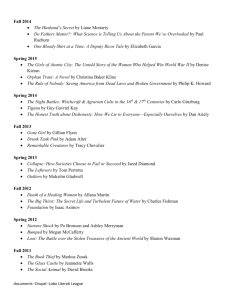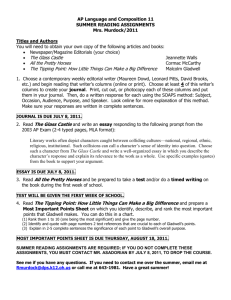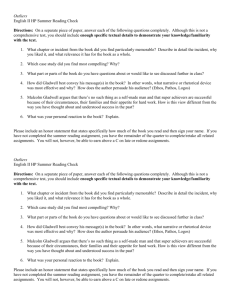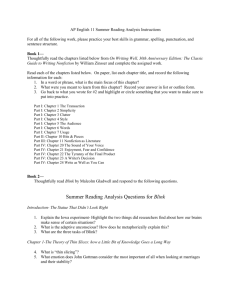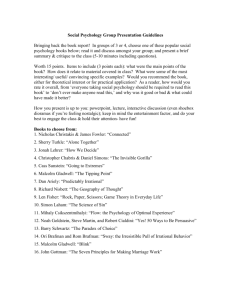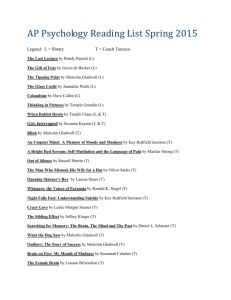Free Executive Summary - The Investors Podcast
advertisement
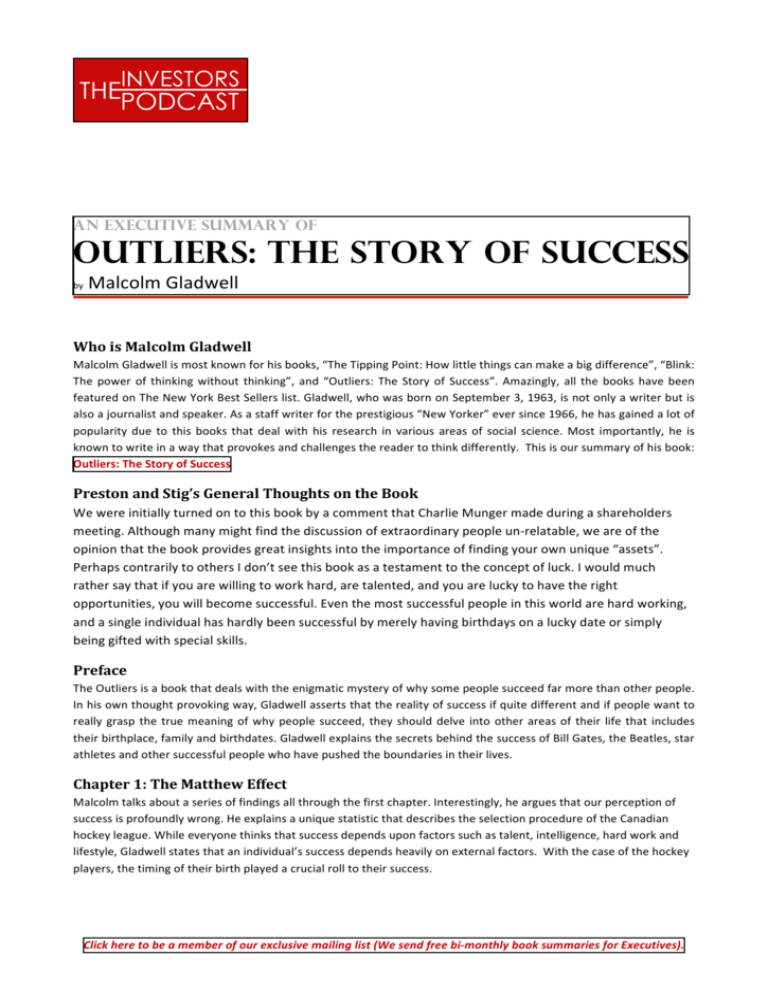
An Executive Summary of OUTLIERS: THE STORY OF SUCCESS by Malcolm Gladwell Who is Malcolm Gladwell Malcolm Gladwell is most known for his books, “The Tipping Point: How little things can make a big difference”, “Blink: The power of thinking without thinking”, and “Outliers: The Story of Success”. Amazingly, all the books have been featured on The New York Best Sellers list. Gladwell, who was born on September 3, 1963, is not only a writer but is also a journalist and speaker. As a staff writer for the prestigious “New Yorker” ever since 1966, he has gained a lot of popularity due to this books that deal with his research in various areas of social science. Most importantly, he is known to write in a way that provokes and challenges the reader to think differently. This is our summary of his book: Outliers: The Story of Success Preston and Stig’s General Thoughts on the Book We were initially turned on to this book by a comment that Charlie Munger made during a shareholders meeting. Although many might find the discussion of extraordinary people un-­‐relatable, we are of the opinion that the book provides great insights into the importance of finding your own unique “assets”. Perhaps contrarily to others I don’t see this book as a testament to the concept of luck. I would much rather say that if you are willing to work hard, are talented, and you are lucky to have the right opportunities, you will become successful. Even the most successful people in this world are hard working, and a single individual has hardly been successful by merely having birthdays on a lucky date or simply being gifted with special skills. Preface The Outliers is a book that deals with the enigmatic mystery of why some people succeed far more than other people. In his own thought provoking way, Gladwell asserts that the reality of success if quite different and if people want to really grasp the true meaning of why people succeed, they should delve into other areas of their life that includes their birthplace, family and birthdates. Gladwell explains the secrets behind the success of Bill Gates, the Beatles, star athletes and other successful people who have pushed the boundaries in their lives. Chapter 1: The Matthew Effect Malcolm talks about a series of findings all through the first chapter. Interestingly, he argues that our perception of success is profoundly wrong. He explains a unique statistic that describes the selection procedure of the Canadian hockey league. While everyone thinks that success depends upon factors such as talent, intelligence, hard work and lifestyle, Gladwell states that an individual’s success depends heavily on external factors. With the case of the hockey players, the timing of their birth played a crucial roll to their success. Click here to be a member of our exclusive mailing list (We send free bi-­‐monthly book summaries for Executives). For instance, 40% of the players in the hockey league were born between the months of January and March, 30% between April and June, 20% between July and September and the remaining 10% were born between October and December. This simply means that a child born in January has a significant advantage over the other kids because he is going to be more physically and mentally mature than the other kids. These privileged kids will be selected to the best teams receiving even better coaching, and train with even better teammates, compounding the built-­‐in advantage they have over kids born later that year. Gladwell provides several other examples in baseball, hockey and soccer to prove that children born earlier have a certain advantage. Further, he compares this concept in the education system and asserts that parents with children born in later months often try to hold their child back before beginning kindergarten for the same reason. As Gladwell talks about the advantages, it makes one wonder whether talent plays a role in success. As an answer, Gladwell agrees that it does play a role; however, it might not be as highly important as you may think. Not everyone who’s born in January that plays hockey becomes an instant success, but there are other factors that could help a person to become successful. A sociologist named Robert Merton coined this phenomenon as the “Matthew Effect”, which states that people who receive special advantages during their lives are more likely to attain success. Chapter 2: The 10,000-­‐Hour Rule If a person’s success isn’t based solely on his ability or talent, what really makes an individual successful? According to Gladwell, it also depends on the “10,000 hour rule”, which states that it takes approximately 10,000 hours of practice for an individual to achieve mastery in any field. Moreover, this rule applies to a child if he/she enters into some kind of special program that offers incredible opportunities, thus giving him a chance to put in those hours of practice. To explain this concept further, Gladwell takes the example of Bill Joy, Bill Gates and the Beatles. Bill Joy, the co-­‐founder of Sun Microsystems, found that he was presented with a string of opportunities to help him succeed. Interestingly, he was able to attend one of the only universities that offered a time-­‐sharing system for its computers and since the computers had a bug, he was able to access them for an unlimited amount of time. In an interview with Gladwell, he stated that it took him 10,000 hours to practice and write programs that are used by millions of people even today. Similarly, Bill Gates experienced numerous coincidences as he happened to attend the only private school that allowed a time-­‐sharing system with their computers. Bill Gates, just like Bill Joy, used the opportunity to his advantage and the fact that he lived close to the University of Washington that offered free computer hours helped him too. Upon taking a closer look on the biography of Beatles, it is interesting to note that they had the opportunity to practice and master their skills when they were struggling as a high school band. Incredibly, they played about 1200 times in night clubs between 1960 and 1965, thus catapulting them towards success. Based on these findings, Gladwell concludes that the people born between 1954 and 1955 had a greater opportunity to become successful within the computer industry. People who experienced a raging success included Bill Gates, Paul Allen, Steve Blamer, Steve Jobs, Eric Schmidt, Vinod Khosla and many others. The reason was that they had the right age and opportunities to put in the hours and become skilled before the computer boom. Click here to be a member of our exclusive mailing list (We send free bi-­‐monthly book summaries for Executives). Chapter 3: The Trouble with Geniuses, Part 1 In this section, Gladwell talks about how people are awed by geniuses with higher IQ levels. He notes that Christopher Langan, a genius, has gained celebrity status as an outlier. With his IQ over 195, a number that was more than Albert Einstein’s IQ of 150, he’s considered by many people as the smartest man in America. Gladwell also talks about Lewis Terman, a professor in the Stanford University who decided to test the IQ of a boy named Henry Cowell. Cowell’s IQ, which was at 140 points, stunned Terman because that was very close to the genius level. Commonly, people think that these men are destined to achieve greater things because they are so smart. Terman created a group of highly intelligent children who were selected after various IQ tests. For years, Terman kept track of ‘Termites’, a name given to the geniuses in his group. However after years passed, Terman, who expected his Termites to become great leaders in the society, was disappointed to discover that achievement and intellect weren’t connected. Gladwell explains this concept further by asserting that an individual’s IQ or intelligence does matter; however, it must reach or go beyond a certain threshold. It’s very similar to basketball where a player surely gains an advantage due to his height, but the height, just like intelligence, has a threshold too. Simply put, if one has an IQ of about 120, additional IQ may not really help him. It is other factors outside of raw intelligence that determines how successful you will become. Chapter 4: The Trouble with Geniuses, Part 2 In this section, Gladwell compares the history of two geniuses namely Christopher Langan and Robert Oppenheimer. He further states that if Langan was born in a wealthy family of doctors with several high connections, he would probably be a doctor today. Langan was born to an abusive father and irresponsible mother. As a kid, he faced several difficulties and at one point, he even lost a scholarship from the Reed College simply because his mother was unable to fill out the necessary paperwork. Langan worked in factories and also as a bouncer at a bar located on Long Island. On the other hand, Robert Oppenheimer, who gained immense popularity as a physicist during the World War II, was born in a rich family to a successful businessman. He had the opportunity to attend the best colleges when he was very young and although his thought process was similar to Langan’s thinking, he had the ability to carve out a way for himself in the worst of the situations. Gladwell states that Oppenheimer’s practical intelligence was definitely a major factor in his success. To emphasize his point, Gladwell presents the findings of a study conducted by Annette Lareau. The study delved deep into the parenting styles of rich families in comparison with poorer families. Incredibly, Lareau discovered that children who grew up in a sophisticated environment were able to better communicate with others including questioning authorities, while children who grew up in poorer families usually avoided such situations. Since Langan was born in a poor family, he wasn’t able to function like Oppenheimer and there was nothing he could do about it. Similarly, Terman’s ‘Termites’ met the same fate as none of the kids who were from a poorer background were able to make a name for themselves. Chapter 5: The Three Lessons of Joe Flom In this section, Gladwell talks about a Jewish man, Joe Flom, who has the perfect rags-­‐to-­‐riches story. Flom tasted spectacular success and, up to his death, earned almost $1 billion every year. However, Gladwell implores the reader Click here to be a member of our exclusive mailing list (We send free bi-­‐monthly book summaries for Executives). to apply everything that’s been explained in the first four chapters and understand that success doesn’t pop up out of nowhere. Successful people don’t really achieve it all by themselves and their background clearly matters. Lesson One: The Importance of being Jewish Alexander Bickel, a man who tried to get a job in Mudge Rose, was one of Flom’s classmates from the Harvard University. Bickel’s background was similar to Flom’s because he too was the son of a Jewish immigrant couple, and he, just like Flom, went to a school in New York before attending the City College. However, he was denied a job in Mudge Rose since the senior partner felt that their firm would face limited possibilities of growth if they were to hire a boy of his antecedents. Therefore, Flom and Bickel found jobs at other undesirable firms with less work. However, with a twist in fate, these jobs, including litigations and hostile takeovers, suddenly became amazing opportunities when the industry experienced a major boom in mergers and acquisitions. The best part was that their undesirable jobs were suddenly something everyone wanted to do and so, Bickel, Flom and others were in a perfect position to exploit the situation to their advantage. Lesson Two: Demographic Luck Gladwell talks about the interesting story of Maurice Janklow, a son of a Jewish immigrant couple. He attended the Brooklyn Law School way back in 1919 and bought a writing-­‐paper firm and it appeared like he was about to make it big. However, the business failed and Maurice struggled, but his son Mort Janklow went on to amass a fortune when he conducted business with Cox Broadcasting. Gladwell compares the stories of both the father and son and states that the timing of their birth played a key role in their success. While Maurice bought the business when the US was almost on the verge of the Great Depression, Mort who was born in the 1930s was perfectly poised to take up good education and become a successful lawyer. Gladwell declares that the 1930s was perfect for aspiring lawyers, just like it was for the software programmers who were born in 1955. Lesson Three: The Garment Industry and Meaningful Work In this section Gladwell explains how Jews were unlike any other immigrants. He talks about Louis Borgeicht, an immigrant from Poland and Regina Borgeicht, an immigrant from Hungary. Once the couple realized that there was a solid demand for clothes in New York, Louis began manufacturing aprons at home while Regina assisted in selling them on the streets. The couple couldn’t own their own land in Europe, but they were experienced and knew how to live in big cities. Moreover, they had specific skills in making clothing and a great boom in the garment industry opened several doors for them. An entrepreneur working in the garment industry found that it was meaningful work since it was linked with complexity, autonomy, and a perfect connection between hard work and reward. Upon inspecting the family trees of Jewish immigrants created by Louise Farkas, a sociology student, Gladwell points out that there are definite similarities between how they began working and while the second generation usually consisted of garment manufacturers, the children born to them went on to become successful, educated professionals. Though the Jews faced disadvantages as immigrants, they ultimately proved to be incredible opportunities. Click here to be a member of our exclusive mailing list (We send free bi-­‐monthly book summaries for Executives). Chapter 6: Harlan, Kentucky In this section, Gladwell emphasizes how cultural legacies operate like powerful forces, spreading to several generations one after the other. Although we see numerous alterations in our economical, demographical and social conditions, our cultural legacies play an important role in directing our behavior. To explain his point further, Gladwell th discusses several unexplainable events that occurred in the 19 century in Harlan, Kentucky. The Harlan County, situated on the Cumberland Plateau, was founded by about eight families that existed in the British Isles. After a period of time, two families fought with each other and what had started as a small fight in poker turned out so violent that people were killed in the dozens after several brutal attacks. Interestingly, this was only one among several other feuds that were occurring all over Kentucky at the same time. So, how do you explain this phenomenon? As an answer, sociologists addressed that several original inhabitants from England, Scotland and Northern Ireland believed in the “Culture of Honor”, which stated that they had to prove themselves to be strong and valiant. In other words, their honor and reputation was most important for the herdsmen. In another study conducted by Richard Nisbett and Doy Cohen at the University of Michigan, several students who were about 18 to 20 years old were subjected to a myriad of insults before they returned back to their classrooms. The reactions displayed by the students were measured by taking a closer look at their facial expressions, hormone levels in saliva, handshakes and other factors. Astonishingly, the results displayed that the students hailing from the southern states were absolutely furious and researchers attributed this to their cultural legacy. In addition, there were evident differences in the reactions of these students when compared to others from different regions. Chapter 7: The Ethnic Theory of Plane Crashes The concept of cultural legacy goes further beyond a feud that occurred in the Harlan County. In fact, the concept can account for the tragic air crashes that occurred from 1988 to 1998 in the flights run by Korean Air. At that point of time, Korean Air was considered highly unsafe for travel since their crash rates were about 17 times higher than that of the United Airlines. A deep investigation commenced where they reviewed all the data pertaining to the Avianca 052 crash that occurred in 1990. There are several factors involved in a plane crash and though it’s not a result of any specific error, it’s a combination of several errors that often lead to disastrous outcomes. Captain Laureano Caviedes, the pilot of Avianca 052, wasn’t drunk or drugged; in fact, he was exhausted after being held up for about 77 minutes by the Air Traffic Controller (ATC). Finally, he was granted clearance to land, but since the headwind plummeted substantially, the plane couldn’t land. Unfortunately, the autopilot wasn’t even working and though the pilot tried to save the plane by circling around with the intention of landing again, the engines died resulting in a huge crash that claimed 158 lives. He had simply run out of gas. This information makes one question as to why the plane crashed even when both the pilot and first officer were aware of the fuel shortage. At this point, Gladwell presents a transcript of the conversation that was retrieved from the black box and it’s quite obvious that the primal reason for the crash was the first officer’s inability to communicate effectively in such a catastrophic situation. Upon further investigation, it was found that Klotz, the man supposed to communicate with ATC had engaged in “mitigated speech”, a term used by linguists to describe people who have a tendency to cover up or sugarcoat things. Click here to be a member of our exclusive mailing list (We send free bi-­‐monthly book summaries for Executives). In the airline industry, pilots receive a lot of respect and have the ability to command others in undesirable situations, but Klotz who was a first officer, had problems communicating the exact message when the plane was about to crash. You would expect frantic activity in the cockpit in such frantic situations, but incredibly there was a lot of silence in this event and Klotz never told the ATC that they would crash if they weren’t given immediate attention. Since Klotz hailed from a country that had a different cultural legacy, he wasn’t able to get his point across when the situation called for it. To explain his findings further, Gladwell discusses a study that showed that people from low PDI countries (Power Distance Index) usually tend to downplay authority while people from high PDI countries abide with respect for authority. In other words, Klotz who was from Columbia, a high PDI country, couldn’t downplay the authority of the officer in ATC and thus headed to a fatal crash. Fortunately, Korean Air realized where they went wrong when their pilots were using the same mitigated speech patterns, thus failing to communicate. After they identified this problem, they amended it and Korean Air is now considered very safe to travel. One way that this was done was to change the language in the cockpit to English. Compared to Korean where you can speak in four different forms depending on the rank and politeness of the person you speak to; English is a language with lower power distance. An informal tone is crucial in emergencies, where communication needs to be quick and without any misunderstandings. Chapter 8: Rice Paddies and Math Tests Gladwell states that Asians are generally more adept at mathematical calculations than other westerners. For example, if a group of people had 20 seconds to memorize the number 4,7,8,5,9,6,7, most Chinese people would usually get the entire sequence right whereas only 50% of English speakers would be able to report the numbers aloud in a proper sequence. Why? Well, since humans can memorize information in just a span of two seconds and since Chinese numbers are shorter, they have an advantage. Moreover, Asian children generally learn counting at a very tender age and since their languages are constructed differently, it makes it easy for them to grasp numbers. Gladwell then talks about how rice cultivation had a major effect on the cultural legacy of China. As rice cultivation demands specific set of skills and extra efforts, it is known that the people who cultivated rice work more than any other type of farmer. The Chinese believe in working hard and shun laziness. Gladwell concludes that the Chinese legacy that believes immensely in hard work, cooperation and smart planning will definitely reap great results over time. Mathematics is not dependent on talent, but it is dependent on the individual’s persistency; therefore, Asians are well adept to it from their cultural legacy. A research conducted by Erling Boe states that there is a direct link between countries and math rankings on the TIMSS, a test used to evaluate academic achievements between countries. Countries that do amazingly well on TIMSS are Singapore, China, Japan, Hong Kong and South Korea. Chapter 9: Marita’s Bargain Gladwell reiterates the importance of cultural legacy and how it can change lives drastically. He talks about KIPP, a public school in New York that focuses completely on achievements and academics. KIPP has certainly garnered a lot of attention primarily because it has managed to help poor students with low income. We already know how countries that focus on rice cultivation are known to work hard. Our cultural legacy is interconnected to our attitude and behavior and the western cultural legacy is in contrast with other countries. While rice paddies are grown several Click here to be a member of our exclusive mailing list (We send free bi-­‐monthly book summaries for Executives). times a year, corn and wheat fields of the western culture follow a procedure of planting, harvesting and then resting a while. Interestingly, this trend can be seen even in western educational systems where the number of working days in a year is only about 180, which is much lower than schools that run for 220 days in South Korea or 243 days in Japan. Karl Alexander, a sociologist, noticed a fascinating pattern among children in Baltimore. He noted that there was a considerable gap between children hailing from wealthy families and other kids who were from poorer families. What’s more interesting is that he found this gap in their achievements only after the summer vacations, which meant that while the rich kids ameliorated their skills during summer, the poorer kids relapsed. Gladwell states that the schools in western countries should increase the number of working days just like KIPP. For instance, students in KIPP attend school right from 7.25 am to 7 pm on weekdays and from 9 am to 1 pm on Saturdays. During the summer days, school was held from 8 am to 2 pm consistently. They follow the Asian structure where students work hard from dusk to dawn, thus becoming highly disciplined. Needless to say, the students also receive a lot of attention from their teachers and though at least 80% of poor children enroll into schools, students in KIPP get a head start to achieve something in their lives. Conclusion: A Jamaican Story In this section, Gladwell talks about his own rags-­‐to-­‐riches story where his grandmother, a Jamaican slave, was taken by William Ford as a concubine. Gladwell tracks his history back to his mother who became a prominent writer in Canada. He also states that there were several opportune events that shaped their family’s success. Truly, Gladwell has been able to completely transform the way success is perceived by most people. An outlier is one who has the ability to snatch golden opportunities and carve his beautiful future. As a conclusion, it is safe to say that success is a combination of hard work, opportunities, and talent. Click here to be a member of our exclusive mailing list (We send free bi-­‐monthly book summaries for Executives). Read Reviews for OUTLIERS: THE STORY OF SUCCESS on Amazon FreeExecutive summaries Sign-up for our mailing list of www.TheInvestorsPodcast.com/Sign-­‐Up Click here to be a member of our exclusive mailing list (We send free bi-­‐monthly book summaries for Executives).

